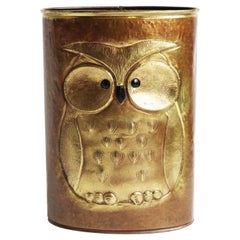Micap Belgium
Recent Sales
Vintage 1960s Belgian Hollywood Regency Umbrella Stands
Brass
A Close Look at Hollywood-regency Furniture
The California-born style of Hollywood Regency, also known as Regency Moderne, emerged during the Golden Era of cinema from the 1920s to the ’50s. Decadent and bold, vintage Hollywood Regency furniture and interiors playfully mix colors like jewel tones and hot pinks with lacquered walls, gilded accents, mirrored surfaces and metallic finishes for maximalist spaces.
Although it involved elements of the coinciding Art Deco movement, such as a preference for clean lines, Hollywood Regency was much more opulent, inspired by glamorous movie stars and the lavish set designs for films being made in Tinseltown. Furniture designers associated with the style embraced an eclectic range of influences, including throwbacks to previous styles of grandeur, such as Rococo, neoclassical and chinoiserie, as well as materials, from bamboo dining chairs to lucite bar carts to sunburst mirrors made from gilded resin. Hollywood Regency end tables, floor lamps, chandeliers and other pieces tended to be small-scale, fitting into an overall design rather than serving as a focal point.
Interior decorator Dorothy Draper led the shaping of the Hollywood Regency style and also designed iconic pieces like the España chest, which was manufactured by Henredon. Virginia native William “Billy” Haines, a furniture designer who started as an actor, contrasted hand-painted wallpaper with Chinese ceramics and Chippendale chairs, while architect John Elgin Woolf imbued his Beverly Hills designs with theatrical details. Paul Revere Williams, a trailblazing African-American architect, was pivotal in defining the look through his commercial projects, such as the 1940s Beverly Hills Hotel and bespoke homes that mixed everything from Louis XV paneling to Georgian architecture.
Find a collection of vintage Hollywood Regency bedroom furniture, tables, seating and other pieces on 1stDibs.
Finding the Right Umbrella-stands for You
When it’s raining, you’re going to need an umbrella, and that wet umbrella is going to need a home. In the range of vintage, new and antique umbrella stands on 1stDibs, find patio umbrella stands made for the outdoors and luxury iterations intended to pair with your coat rack and add a dose of character to your entryway.
Modern umbrellas originated as parasols or sunshades for the upper classes in Ancient Egypt, Ancient India and elsewhere, with the accessory undergoing significant improvements, which included waterproofing, in China thereafter. The Chinese created collapsible accessories and applied wax and lacquer to paper parasols, which repelled rain during thunderstorms. As umbrellas saw widespread adoption over the years, we suddenly needed a place to put them.
African-American inventor William C. Carter of Cincinnati, Ohio, patented the first umbrella stand in 1885. His receptacle featured horizontal crossbars with hinged ends that allowed for umbrellas to be spring-locked into place. Carter hoped his idea would prevent theft of umbrellas and canes as well as present an orderly solution for storing them. It could hold more than one umbrella and contained a drip pan to catch rainwater. Today, antique umbrella stands are rich components of home decor — they’re among the first furnishings you see when you enter someone’s house or apartment — and those stemming from Carter’s day are precious collector’s items.
While preliminary umbrella stands were simple (no more than two posts and a rack to hold several umbrellas), furniture makers embellished their interpretations, adding decorative flourishes and improving upon its features over time.
On 1stDibs, a collection of antique 19th-century umbrella stands includes structures made of oak, walnut and more. There are understated Victorian-era umbrella stands made of brass that comprise little more than four tubular metal supports and cast-iron drip pans, while iterations dating from the same era made from mahogany feature distinctive hand-carvings on their side panels or ornate finials. If they’re not cast-iron umbrella stands, a (sometimes removable) cast-iron drip pan at the very least is a fairly consistent characteristic of the stands of the era.
Mid-century modern furniture designers explored venturesome forms and worked with a variety of materials to craft their umbrella stands, integrating metals such as aluminum and introducing glass and even marble to these pieces. Umbrella stands crafted by contemporary furniture makers often depart from their historical counterparts. While a sampling of today’s iterations demonstrate that creators are making umbrella stands in a variety of shapes and sizes, they’re frequently embodying clean lines and minimalist flourishes, which are perhaps a good fit if you don’t intend for your rack to stand out in your foyer or entryway.
If you’re looking to make a statement with your patio umbrella stand or the piece you’re intending to keep indoors, a vintage ceramic umbrella stand will introduce a pop of color or a dazzling texture to your doorstep or to the neutral color palette that characterizes your entryway.
While umbrella stands have seen an evolution of design over the years, their usefulness hasn’t changed a bit. Browse a collection of antique, new and vintage umbrella stands today on 1stDibs.
